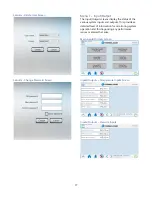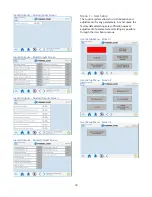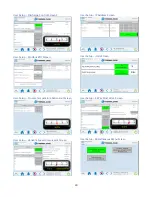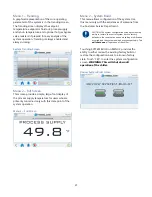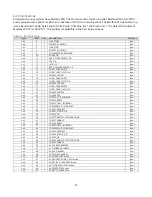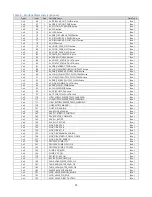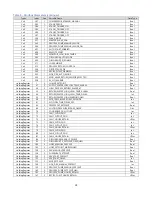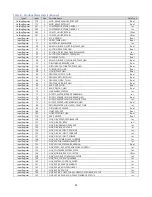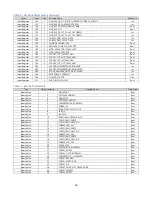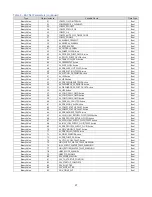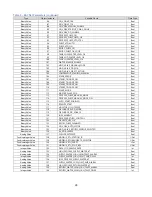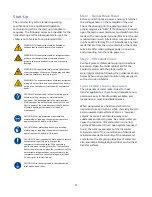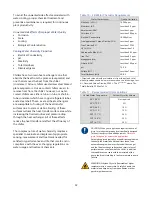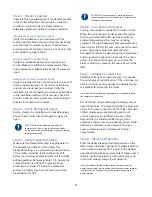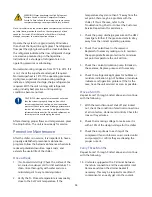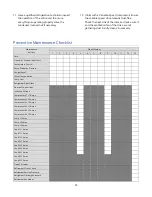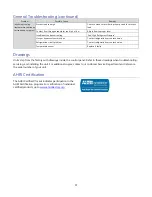
31
Start-Up
The unit is factory set to standard operating
specifications. Use a qualified refrigeration
technician to perform the start-up procedure in
sequence. The following serves as a checklist for the
initial start-up and for subsequent start-ups if the
chiller is out of service for a prolonged time.
WARNING: This equipment contains hazardous
voltages that can cause severe injury or death.
WARNING: This equipment contains refrigerant under
pressure. Accidental release of refrigerant under
pressure can cause personal injury and or property
damage.
WARNING: This equipment may contain fan blades or
other sharp edges. Make sure all fan guards and other
protective shields are securely in place.
WARNING: The exposed surfaces of motors, refrigerant
piping, and other fluid circuit components can be very
hot and can cause burns if touched with unprotected
hands.
CAUTION: Disconnect and lock out incoming power
before installing, servicing, or maintaining the
equipment. Connecting power to the main terminal
block energizes the entire electric circuitry of the unit.
Electric power at the main disconnect should be shut
off before opening access panels for repair or
maintenance.
CAUTION: Wear eye protection when installing,
maintaining, or repairing the equipment to protect
against any sparks, debris, or fluid leaks.
CAUTION: Wear protective gloves when installing,
maintaining, or repairing the equipment to protect
against any sparks, debris, or fluid leaks.
CAUTION: The unit requires the main power to remain
connected during off-hours to energize the
compressor’s crankcase heater. Disconnect main
power only when servicing the chiller. The crankcase
heater should remain on when the compressor is off to
ensure liquid refrigerant does not accumulate in the
compressor crankcase. Connect main power at least
24 hours prior to initial start-up.
CAUTION: Wire the unit ground in compliance with
local and national codes.
Step 1 - Connect Main Power
Before connecting main power, ensuring it matches
the voltage shown on the nameplate of the unit.
Check the phasing prior to applying power. The
proper sequence is “ABC.” If the phasing is incorrect,
open the main power disconnect and switch two line
leads on the main power terminal blocks (or the unit
mounted disconnect). All electrical components are
in-phase at the factory. Do not interchange any load
leads that are from the unit contactors or the motor
terminals. After making proper power connection
and grounding, turn the main power on.
Step 2 - Fill Coolant Circuit
Verify all process chilled-water piping connections
are secure. Open the chiller cabinet and fill the
coolant reservoir with the proper water or
water/glycol solution following the guidelines shown
below. When using a glycol solution only use glycol
with a corrosion inhibitor.
System Fill Water Chemistry Requirements
The properties of water make it ideal for heat
transfer applications. It is safe, non-flammable, non-
poisonous, easy to handle, widely available, and
inexpensive in most industrialized areas.
When using water as a heat transfer fluid it is
important to keep it within certain chemistry limits to
avoid unwanted side effects. Water is a “universal
solvent” because it can dissolve many solid
substances and absorb gases. As a result, water can
cause the corrosion of metals used in a cooling
system. When water is in an open system (exposed
to air), the water evaporates but the dissolved
minerals remain. If the concentration of dissolved
minerals exceeds the solubility of the mineral and
scale forms. The life giving properties of water can
also encourage biological growth that can foul heat
transfer surfaces.

